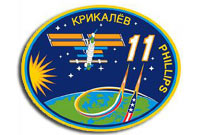NASA Space Staiton Status Repport 13 May 2005

Expedition 11 Commander Sergei Krikalev and Flight Engineer John Phillips continued routine maintenance and science experiments aboard the International Space Station this week as they wrapped up their first month in space.
The crew began the week observing Victory Day – the Russian holiday that this year marked the 60th anniversary of the end of fighting in the Soviet Union during World War II. The rest of the week kept Krikalev and Phillips busy with maintenance and research activities.
The crew continued using the treadmill for exercise this week as engineers closely monitored data from the exercise sessions. However, after a broken restraint cable was found during a routine inspection today, the crew was asked to use other exercise equipment for the time being.
The treadmill stopped working for a time last Friday when a circuit breaker tripped inside the device. During a routine monthly inspection today, Phillips reported a broken restraint cable on the treadmill’s gyroscope. The treadmill, which is specially outfitted to isolate the vibrations caused by exercise from the rest of the Station, is equipped with a gyroscope to maintain the system’s stability.
Engineers will analyze photos of the restraint cable to determine if it can cause problems with the treadmill’s operation. Other exercise equipment aboard that is available to the crew includes two stationary bicycles.
The Station’s atmosphere was pressurized with oxygen from the ISS Progress 17 vehicle’s reserve tanks once again this week. The Station’s Elektron oxygen generation system, which can convert water into oxygen for the air onboard, is not operating. Russian engineers plan to send a new electronics box for the system on a Progress supply ship that will arrive in June.
Plentiful supplies of oxygen remain available aboard the Station from multiple sources. In total, oxygen supplies already aboard the Station coupled with those that are planned to be delivered by upcoming cargo craft could sustain the crew for at least the rest of this year, without use of the Elektron.
Through next week, the remaining oxygen supplies aboard the currently docked Progress will be used. Once those are depleted, Solid Fuel Oxygen Generation canisters may be used. 84 such canisters are aboard. Those canisters alone could supply the crew for at least 42 days if necessary. A large quantity of oxygen, enough to supply the crew for nearly 100 days, also is stored in tanks on the Quest airlock aboard the Station.
The Progress spacecraft now docked to the Station, Progress 17, will undock at about 3:10 p.m. CDT June 15. ISS Progress 18 is scheduled to launch from the Baikonur Cosmodrome, Kazakhstan, at 6:09 p.m. CDT June 16 and dock to Station on at 7:10 p.m. CDT June 18. The Station’s altitude was boosted on Wednesday to line up its orbit for the arrival of the new cargo craft. The Station’s orbit was raised by 1.5 miles at the perigee, or portion closest to Earth, to 226.1 by 214.2 statute miles. The new Progress also is planned to deliver even more oxygen supplies. Another Progress craft is planned to arrive at the Station in late August.
This week, both crewmembers worked on preparing excess equipment for return on the Space Shuttle Discovery in July on the STS-114 Return to Flight mission. They also performed routine maintenance on ventilation and life support systems in the Russian segment and verified a VHF radio communications link used during Shuttle rendezvous operations. Krikalev continued work throughout the Russian modules with audits of various supplies and equipment.
Phillips’ work focused on some of the laptop computers aboard. He refreshed a Portable Computer System (PCS) laptop by deleting and then reloading information on the hard drive, which recovered its corrupted hard drive to serve as a backup. The PCS laptops are used by the crew to monitor the Caution and Warning system and manage the Station operating modes and the Command and Control System. Two required PCS computers are functional onboard with three additional hard drives now available as spares.
Phillips also worked with three Station Support Computers (SSCs) that were experiencing problems booting up. After the troubleshooting, two of the computers turned on, but the screens remained blank. They can be used for routing data in applications where a computer monitor is not necessary. The third laptop did not boot up and engineers are working on further troubleshooting procedures. There are enough operating computers available onboard for the crew to access e-mail, perform word processing and view the daily schedule of activities. Phillips also replaced an old battery in the laptop computer used at the Robotics Work Station that controls the Station robotic arm, Canadarm2.
Serving as the NASA Station Science Officer, Phillips began participating in the ‘Journals’ experiment after completing his orientation to Station life. The investigation records crew members’ perceptions though the mission to obtain information to assist in the design of future spacecraft. Phillips also prepared for his first session next week with the Foot/Ground Reaction Forces During Spaceflight (FOOT) experiment. For the experiment, he will wear an instrumented garment called the Lower Extremity Monitoring Suit (LEMS) and shoes with force sensor attached. The experiment records 12 hours of data to help researchers better understand forces imposed on the lower body and muscle activity in weightlessness.
Information on the crew’s activities aboard the Space Station, future launch dates, as well as Station sighting opportunities from anywhere on the Earth, is available on the Internet at:
The next ISS status report will be issued on Friday, May 20, or earlier if events warrant.








